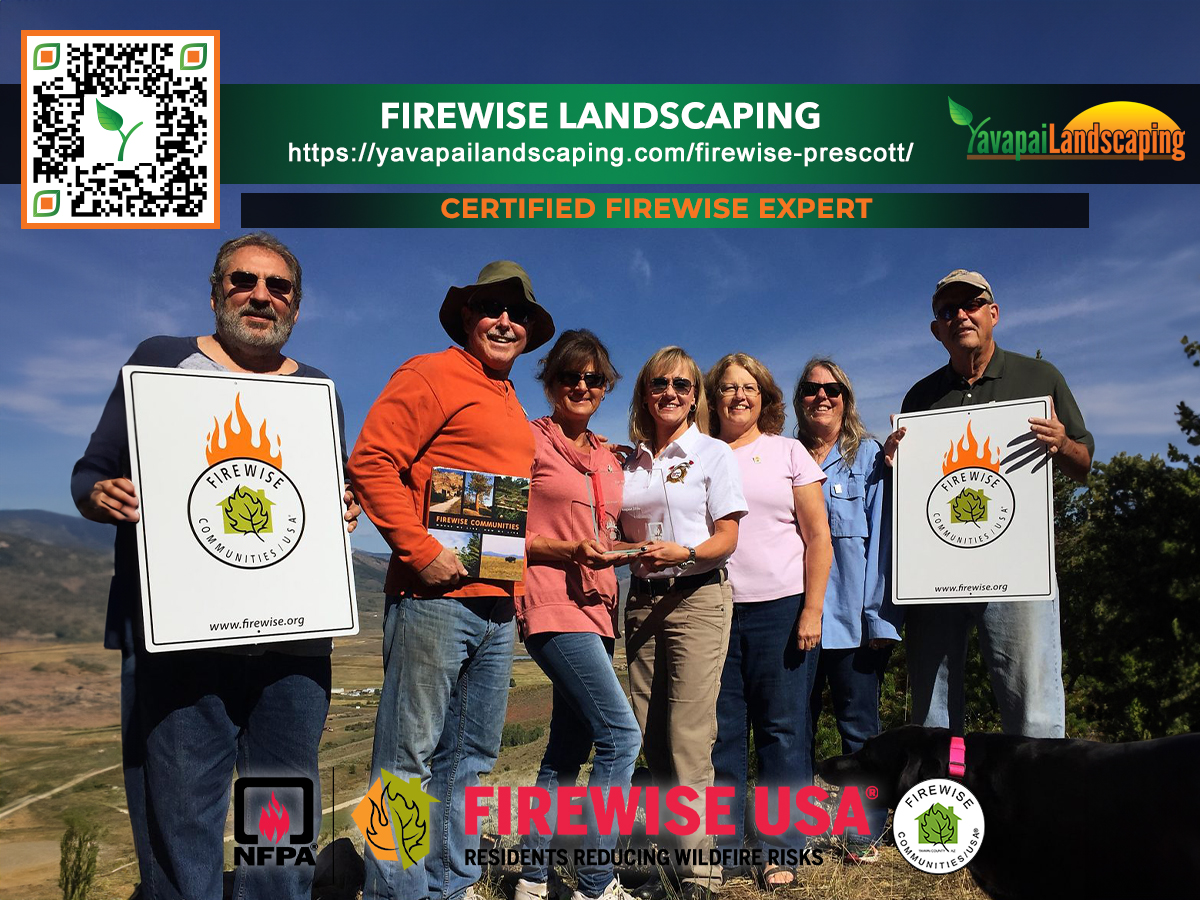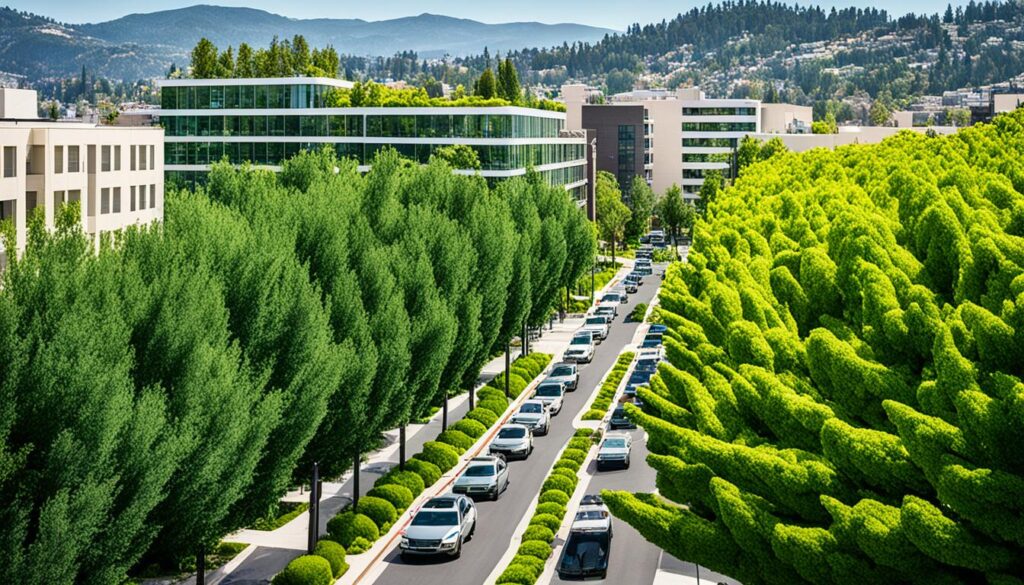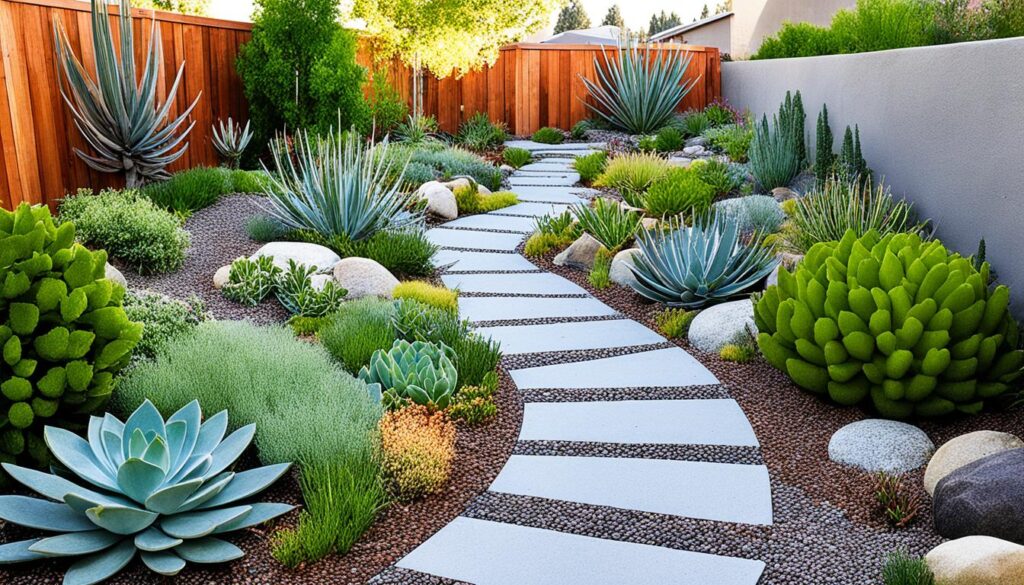
Urban areas face special challenges in preventing wildfires. As cities grow closer to wild areas, making landscapes fire-resistant is key. New solutions mix sustainable design with smart safety steps for city Firewise landscaping.
Now, city folks can make their outdoor areas pretty and fire-free. These designs use fire-resistant plants and smart stone and concrete to boost safety. By doing this, homeowners help fight wildfires in their communities.
Modern Firewise methods for cities aim to use space well. They suggest using tall gardens with fire-safe plants, green roofs to slow fire, and small water features as fire barriers. These ideas show that effective fire-safe landscaping can be achieved even in small city spaces.
Key Takeaways
- Urban Firewise landscaping combines fire safety with an attractive design.
- Fire-resistant plants are key in urban wildfire prevention strategies
- Hardscaping elements play a crucial role in urban fire protection
- Vertical gardens and rooftop spaces offer innovative fire safety solutions
- Water features can act as effective fire breaks in urban settings
- Firewise techniques can be adapted for limited urban spaces

Understanding Firewise Landscaping Principles for Urban Environments
Urban gardening brings its own set of fire safety challenges. You must plan and make smart choices to keep your city garden safe from fires. Here are some key principles to follow for a safer urban garden.
First and foremost, it’s essential to maintain a tidy garden. Overgrown vegetation, dead leaves, and dry debris can fuel and spread a fire quickly. Regularly prune plants, remove weeds, and dispose of any combustible materials. Keep your garden well-watered, especially during hot and dry weather conditions. A well-hydrated garden is less likely to catch fire, and if a fire does occur, it will be easier to extinguish.
Another critical aspect of urban garden fire safety is electrical equipment management. Outdoor lighting, pumps, and other electrical devices can ignite nearby flammable materials. Ensure all electrical equipment is installed and maintained according to local safety codes and regulations. Keep electrical cords and wires away from heat sources, such as barbecues or fire pits, and avoid overloading outlets. Additionally, consider using fire-resistant materials for planters, trellises, and other garden structures to reduce the risk of fire spreading.
Fire pits and barbecues also require special attention in an urban garden. When using these devices, keep a fire extinguisher or a bucket of sand nearby, and ensure that a responsible adult is present to monitor the flames. Never leave a fire unattended; fully extinguish it before leaving the garden. Consider installing a fire-resistant barrier around the fire pit or barbecue area to prevent accidental sparks.
Finally, have a plan in place in case of a fire emergency. Ensure all household members know what to do in case of a fire, including how to call the fire department and exit the premises safely. Keep emergency phone numbers handy, and designate a meeting spot outside the garden where everyone can gather once they’ve escaped. By following these principles, you can enjoy your urban garden while minimizing the risk of fire hazards. Elevate your knowledge with this remarkable piece.
The importance of fire-resistant plant selection
Choosing plants that resist fire is key for city gardens. These plants have a lot of moisture and little oil, so they’re less likely to catch fire. Some top picks include:
- Lavender
- Coneflower
- Sedum
- Penstemon
These fire-resistant plants also handle drought well, ideal for gardeners who save water.
Creating defensible space in limited urban areas
Even in small city spaces, defensible space is crucial. It’s an area around your home that slows down fire. In cities, focus on:
- Keeping plants trimmed and away from buildings
- Removing dead plants often
- Using gravel or stone paths to separate plant areas

Utilizing hardscaping elements for fire protection
Hardscaping is crucial to fire safety in cities, particularly in areas prone to wildfires. You can create effective barriers preventing fires by incorporating fire-resistant materials like concrete, stone, or gravel into your outdoor design. These elements provide a visually appealing aesthetic to your landscape and serve as a vital safeguard against the devastating effects of fire. For instance, a patio or rock garden made from non-flammable materials can act as a firebreak, halting the spread of flames and protecting your property from damage.
In addition to their fire-resistant properties, hardscaping elements can help reduce the risk of ember ignition, a common cause of wildfires. You can create a fire-safe zone around your home or building using materials resistant to ignition, such as gravel or decomposed granite. Furthermore, hardscaping features like retaining walls, planters, and walkways can be designed to divert flames and embers away from structures, providing an added layer of protection. Incorporating these fire-safe design elements into your landscape can significantly reduce the risk of fire damage and create a safer, more resilient outdoor space.
Technological Advancements in Urban Firewise Landscaping
Urban areas are now using the latest tech to make their landscapes Firewise. Smart irrigation systems are key, managing water perfectly to keep plants healthy and saving water. They change watering times based on the weather, keeping fire-resistant plants ready in cities.
Fire-resistant materials have improved, giving people new ways to build and landscape. These materials protect against fire spread. With remote monitoring, people and city officials can watch for fire risks and act quickly.
Urban planning tech is changing how cities fight fires. Advanced software helps make communities safe by planning layouts that follow Firewise rules. It looks at wind and land shapes to lower fire risks in crowded places.
As cities expand, using these tech tools is key. Smart watering, fire-safe materials, remote watching, and city planning tech make cities safer and stronger. This full approach to Firewise landscaping sets new fire safety standards in our cities.
Yavapai Landscaping Prescott offers no-cost estimates for its landscaping and tree services in Prescott and the neighboring regions. These include tree elimination, pruning, stump grinding, land clearance, storm clean-up, and emergency tree care.
